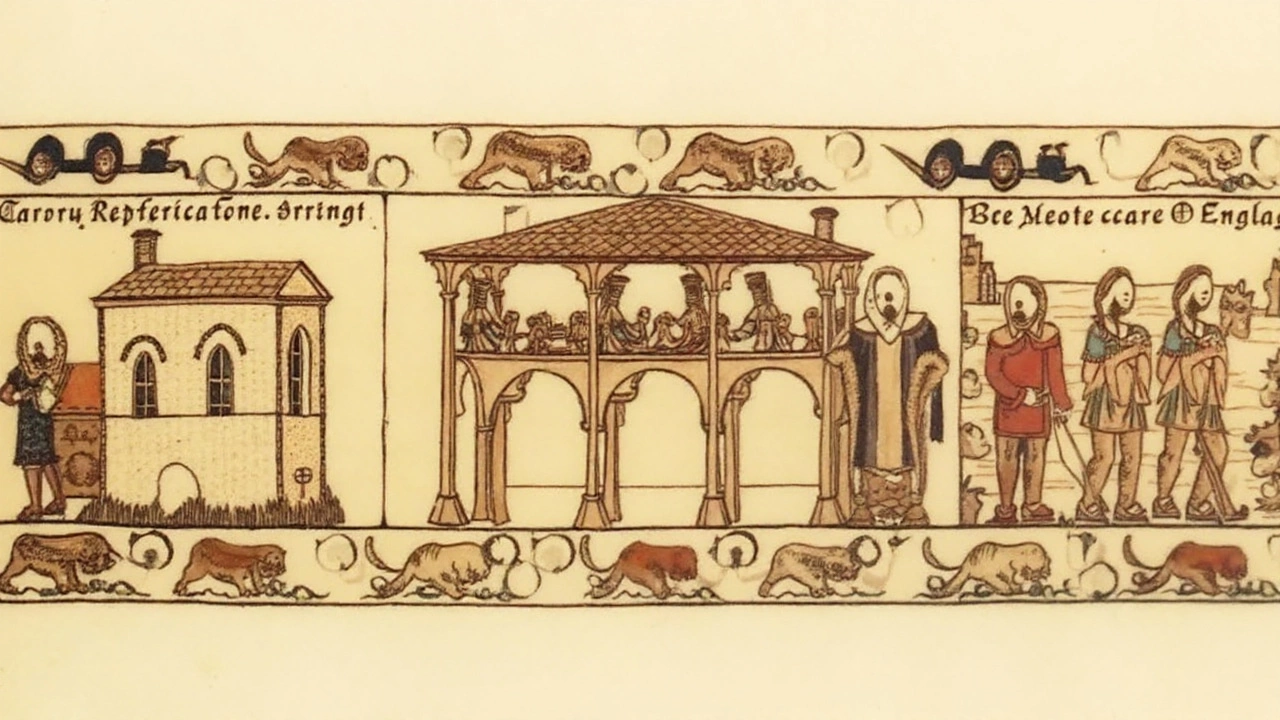An 11th-century toilet that solved a 1,000-year mystery
A medieval toilet buried under a modern house has done what centuries of guesswork couldn’t: pinpoint the royal residence of King Harold Godwinson in Bosham, West Sussex. Archaeologists say the find finally ties the coastal village to the feasting scene in the Bayeux Tapestry, where Harold appears at Bosham just before the events that led to 1066.
The key clue surfaced years ago. In 2006, a small excavation in a private garden uncovered a large timber building and, beside it, a purpose-built latrine. At the time it raised eyebrows. Now, after fresh analysis by researchers from Newcastle University and the University of Exeter, that latrine has become the smoking gun. Toilets inside or immediately beside halls appear in England from the 10th century, but only in the most elite settings. A private, integrated privy was the kind of comfort that marked out power.
The team went back to the old trench notes, examined the building layout, and paired that with new geophysical surveys across the property. The data confirmed two medieval structures: one folded into the footprint of the current house, and another set into the garden. Together they form the heart of an early high-status complex, the kind you’d expect a leading earl—and later a king—to occupy.
Dr. Duncan Wright of Newcastle, who led the study, put it plainly: the toilet was the clincher. In the 11th century, an en-suite arrangement wasn’t just rare—it signaled extraordinary rank. That single feature helped tip the balance from “big old house” to “royal seat,” and it matched what the tapestry and later sources hint about Harold’s ties to Bosham.
The site sits beside a church that still anchors the village today, a pairing common in Anglo-Saxon power centers where lordship and worship went hand in hand. The researchers argue the residence worked as a local hub—part ceremonial space, part administrative base, part domestic home—where Harold’s household could host, govern, and prepare for sea voyages.

From tapestry threads to timber walls: how the pieces fit
Historians have long known Bosham mattered. The Bayeux Tapestry shows Harold there, attending church and taking part in a feast before he sails to Normandy around 1064–65. Those scenes are brief, but they pack meaning: this was a place where he felt at home and in command. The problem was geography. For generations, people asked: which exact spot in Bosham? The new study lands that answer on a specific plot where a modern house now stands.
How did they get from medieval embroidery to GPS coordinates? By combining old dirt with new tech. The 2006 trenches pointed to a big timber hall and a neat, lined privy pit—features you don’t get in a typical village house. This time, the team layered on geophysics to trace what lies under lawns and driveways without digging everything up. Surveys such as magnetometry, ground-penetrating radar, and electrical resistance can pick out wall lines, ditches, and floor levels. Here, they revealed building footprints that lined up with the earlier excavation.
At the center is an elite timber structure. These buildings were rarely simple rectangles. High-status halls often had service rooms, screened-off entrances, and sometimes attached or adjacent conveniences. The latrine here suggests thought-out drainage, privacy, and maintenance—again, the hallmarks of wealth. In Anglo-Saxon England, the move toward indoors sanitation in grand houses starts in the 900s and remains scarce through the 1000s. If you had one, you weren’t just comfortable—you were important.
Harold’s story gives the site its drama. When Edward the Confessor died in January 1066, Harold was crowned king and faced a year of whipsaw crises. He defeated an invading Norwegian army at Stamford Bridge in September, then turned south to meet Duke William of Normandy. Weeks later, he died at Hastings. The Bosham residence sits in the calm before that storm, when Harold operated as England’s most powerful earl and, soon after, as king.
The team’s case doesn’t lean only on one pit, of course. The layout hints at a broader complex—hall, service buildings, and close ties to the church. Taken together, the elements fit a pattern seen at other top-tier sites of the period: centers where lords dispensed justice, raised revenues, fed their retinues, and displayed status for all to see.
What’s striking is how much of Anglo-Saxon elite architecture vanished in the years after 1066. The Norman Conquest reworked the landscape fast. Stone castles rose. Old timber halls were replaced, reused, or abandoned. Names changed, records snapped, and the buildings that defined pre-Conquest power went quiet under later foundations. That’s why a single well-placed clue—a toilet—can carry so much weight. It anchors the story in a specific yard, not just on a tapestry border.
The new paper in The Antiquaries Journal lays out the evidence chain: the 2006 dig, the reappraisal of its finds, and the geophysical mapping that confirmed two medieval buildings still lurking beneath a domestic plot. The authors argue that the “en-suite” arrangement points directly to a residence of the highest rank, which matches Bosham’s starring role in Harold’s known movements before the Norman invasion.
There’s also the matter of how spaces were used day to day. A latrine isn’t just a status symbol; it’s a treasure trove for science. If the pit holds preserved sediments, it can trap microscopic remains—parasite eggs, seeds, pollen—that sketch diet, health, and waste management. That kind of evidence can tell us if residents ate imported spices, relied on local grains, or lived with particular diseases. Future targeted sampling, if permitted, could turn a royal bathroom into a profile of life at the top in the 1060s.
For Bosham, the discovery deepens a story the village has told for centuries. The church still marks the shoreline, and the harbor’s shape hasn’t changed much since the Middle Ages. Add a royal hall next door and you get a picture of a place that mattered strategically. From here, it’s a short sail across the Channel—and in the mid-11th century, sea routes were political lifelines. A base at Bosham would let Harold host envoys, muster ships, and keep an eye on Normandy.
Why does an old toilet matter beyond local pride? Because it forces historians to redraw maps of authority. When we can tie a named person to a specific building, we can ask better questions: Who worked here? How many people ate at this table? How often did the household move between residences? Archaeology isn’t just about objects; it’s about refilling the blanks where written records are thin.
The study also nudges debates around the Bayeux Tapestry. The embroidery isn’t a neutral document; it’s Norman storytelling, stitched after the conquest. But when its scenes line up with solid ground evidence—like a grand feast at Bosham matching a high-status hall—its value as a guide to places and routes gets a lift.
There’s a practical side, too. The site is on private property, and any future excavation depends on the owners and heritage authorities. Geophysics gives a way to understand the footprint without turning a home into an open dig. If more work goes ahead, expect targeted trenches, careful sampling, and a light touch—enough to answer key questions while keeping the place livable.
The broader trend the researchers highlight—high-status latrines appearing from the 10th century—is changing how we imagine elite Anglo-Saxon homes. These weren’t rough timber sheds. They were planned environments with privacy, drainage, and service areas. Think less “mead hall from a movie” and more “complex household with staff, store rooms, and early plumbing.” Even small design choices, like where to put a privy, point to a culture of comfort and control.
For the public, the headline will always be Harold. For specialists, the lasting impact may be methodological: a reminder that modest features can carry the loudest signals. An 11th-century latrine, lined and neatly sited, can distinguish a royal residence from a village hall faster than a handful of pottery ever could.
What happens next? The team has mapped enough to define the core and edges of the complex. Dating samples from wood, mortar traces, or soil in the latrine could tighten the timeline even further. Environmental analysis might show what the household ate and when the space fell out of use—was it abandoned after 1066, or did it pass into Norman hands and get repurposed?
Either way, the find gives rare, concrete texture to a turning point in English history. We talk about kings, battles, and claims to the throne. It’s less common to place a king at his table, next to the church he visited, in the very house where his bathroom still hides under a modern floor. Bosham just supplied that detail—and with it, a clearer view of the world Harold knew before the arrow and the fall.





